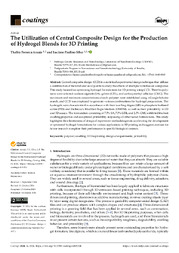The Utilization of Central Composite Design for the Production of Hydrogel Blends for 3D Printing.
The Utilization of Central Composite Design for the Production of Hydrogel Blends for 3D Printing.
Author(s): ARAUJO, T. F.; SILVA, L. P. da
Summary: Central composite design (CCD) is a statistical experimental design technique that utilizes a combination of factorial and axial points to study the effects of multiple variables on a response. This study focused on optimizing hydrogel formulations for 3D printing using CCD. Three biopolymers were selected: sodium alginate (SA), gelatin (GEL), and carboxymethyl cellulose (CMC). The maximum and minimum concentrations of each polymer were established using a Google Scholar search, and CCD was employed to generate various combinations for hydrogel preparation. The hydrogels were characterized in accordance with their swelling degree (SD) in phosphate-buffered saline (PBS) and Dulbecco’s Modified Eagle Medium (DMEM), as well as their printability in 2D and 3D assays. The formulation consisting of 7.5% SA, 7.5% GEL, and 2.5% CMC exhibited the best swelling properties and exceptional printability, surpassing all other tested formulations. This study highlights the effectiveness of design of experiment methodologies in accelerating the development of optimized hydrogel formulations for various applications in 3D printing and suggests avenues for future research to explore their performance in specific biological contexts.
Publication year: 2024
Types of publication: Journal article
Keywords: 3D bioprinting, Design of experiments, Polymer, Printability, Swelling
Observation
Some of Embrapa's publications are published as ePub files. To read them, use or download one of the following free software options to your computer or mobile device. Android: Google Play Books; IOS: iBooks; Windows and Linux: Calibre.
Access other publications
Access the Agricultural Research Database (BDPA) to consult Embrapa's full library collection and records.
Visit Embrapa Bookstore to purchase books and other publications sold by Embrapa.

